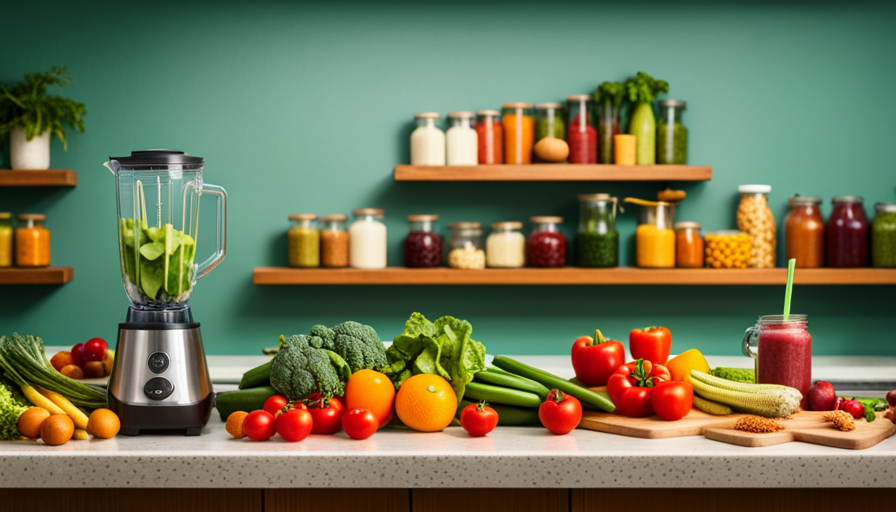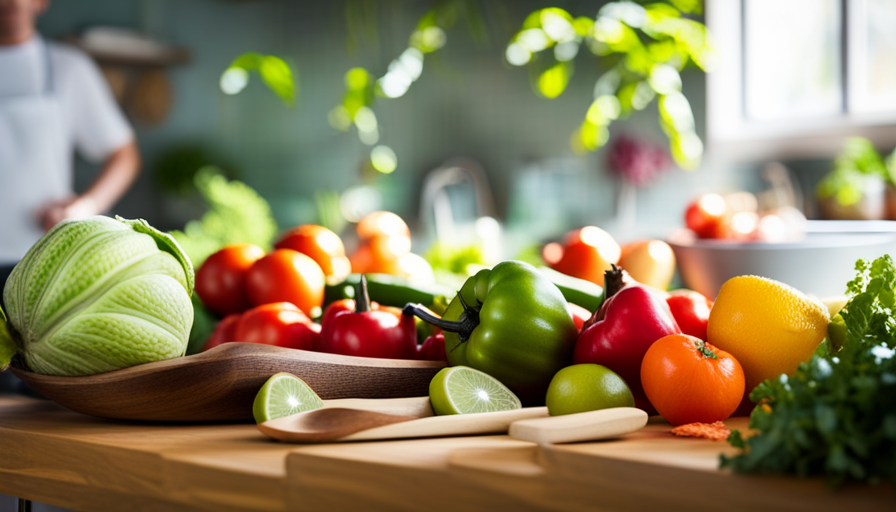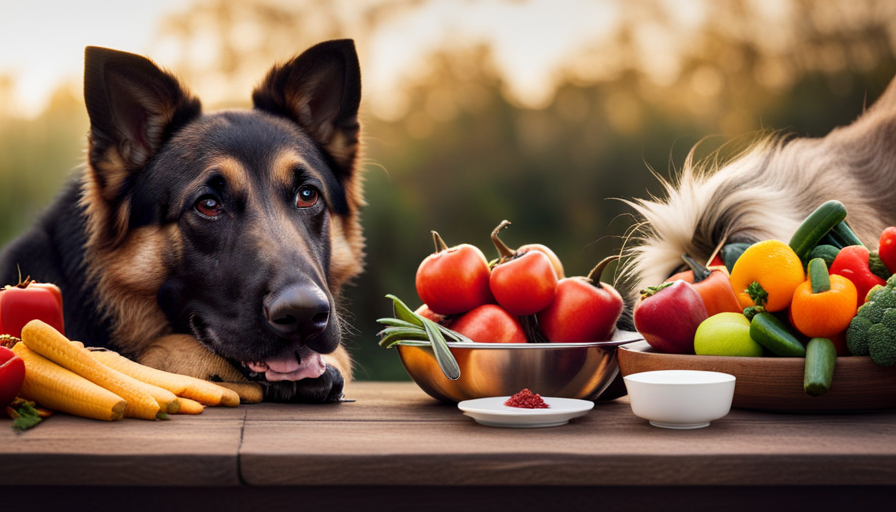Are you prepared to start your quest for radiant wellness and energy? Picture yourself as a seed, poised to burst forth and develop into the finest version of yourself. Adopting a raw food vegan diet is akin to the enriching earth that will support your thriving.
By gradually transitioning to this lifestyle, you can experience the incredible benefits of consuming whole, uncooked plant-based foods.
In this article, we will guide you through the process of slowly transitioning to a raw food vegan diet. You will learn how to set realistic goals, incorporate more raw fruits and vegetables into your meals, explore new preparation techniques, and find delicious and nutritious recipes. Your body’s needs will become your compass, and you will seek support and guidance from the vibrant raw food vegan community.
As you navigate this transition, you may face challenges, but remember that every step forward is a celebration of your progress. Embrace the raw food vegan lifestyle and watch as your mind, body, and spirit align in perfect harmony. It’s time to nourish yourself from the inside out and blossom into the best version of yourself.
Key Takeaways
- Incorporate more raw fruits and vegetables into your diet gradually
- Reduce processed foods and animal products over time
- Experiment with raw food recipes to find delicious and nutritious options
- Seek support from the raw food vegan community for guidance and motivation
Understanding the Benefits of a Raw Food Vegan Diet
Are you ready to experience the incredible, life-changing benefits of a raw food vegan diet? Transitioning to a raw food vegan diet can have a profound impact on your health and well-being. Understanding the science behind this diet can help you make informed choices and find the best substitutes for common non-vegan ingredients.
Raw food veganism is based on the idea that cooking destroys essential nutrients and enzymes in food. By consuming a diet rich in raw fruits, vegetables, nuts, and seeds, you can maximize the nutritional value of your meals. Research has shown that raw food vegans often have lower cholesterol levels, reduced risk of heart disease, improved digestion, and increased energy levels.
Finding substitutes for common non-vegan ingredients is an important part of transitioning to a raw food vegan diet. For example, instead of using dairy milk, you can opt for homemade almond milk or coconut milk. Nutritional yeast can be used as a replacement for cheese, adding a cheesy flavor to your dishes. Additionally, you can use dates or bananas as sweeteners instead of processed sugars.
By understanding the science behind a raw food vegan diet and finding suitable substitutes, you can embark on a journey towards better health and vitality. So, are you ready to take the first step towards a raw food vegan lifestyle?
Setting Realistic Goals for Your Transition
Start by setting achievable goals for yourself that allow you to make small but meaningful changes towards a healthier and more compassionate lifestyle. Transitioning to a raw food vegan diet is a process that requires realistic expectations and gradual changes.
Here are some tips to help you set realistic goals for your transition:
-
Start by incorporating more raw fruits and vegetables into your meals. Aim to have at least one raw meal or snack per day. This could be a refreshing salad or a delicious fruit smoothie.
-
Gradually reduce your intake of processed foods and animal products. Instead of completely eliminating them from your diet right away, try to gradually replace them with healthier alternatives. For example, you can swap out dairy milk for almond milk or replace meat with plant-based alternatives.
-
Experiment with different raw food recipes and find ones that you enjoy. This will make the transition more exciting and sustainable in the long run.
-
Seek support from others who are also transitioning to a raw food vegan diet. Join online communities or find local meetups to connect with like-minded individuals who can offer guidance and motivation.
Remember, the key to a successful transition is to set realistic expectations and make gradual changes that work for you. Don’t be too hard on yourself and celebrate every small step towards your goal.
Incorporating More Raw Fruits and Vegetables into Your Diet
To truly embrace a healthier and more compassionate lifestyle, you can enhance your culinary repertoire by incorporating an abundance of vibrant and nutrient-rich raw fruits and vegetables into your daily meals. One way to do this is by trying out raw food smoothie recipes.
Smoothies are a great way to incorporate raw fruits and vegetables into your diet because they’re easy to make and can be customized to suit your taste preferences. You can start by blending together a variety of fruits like bananas, berries, and mangoes, along with leafy greens like spinach or kale. Adding a liquid base like almond milk or coconut water can help achieve the desired consistency. Experiment with different combinations until you find your favorite flavors.
In addition to smoothies, incorporating raw food snacks into your daily routine can also help you transition to a raw food vegan diet. Snacks like sliced cucumbers, carrot sticks, or cherry tomatoes can be a refreshing and nutritious option. You can also make raw energy balls using ingredients like dates, nuts, and cocoa powder. These snacks can be easily prepared in advance and taken with you on the go.
By incorporating more raw fruits and vegetables into your diet through smoothies and snacks, you can gradually transition to a raw food vegan diet while enjoying delicious and nutritious meals.
Exploring Raw Food Preparation Techniques
By experimenting with different raw food preparation techniques, you can unlock a world of culinary creativity and discover the art of transforming ordinary ingredients into extraordinary dishes. Imagine the satisfaction of creating vibrant salads with spiralized vegetables that resemble colorful ribbons, or the joy of crafting flavorful raw sushi rolls using thinly sliced jicama as a substitute for rice.
One important aspect of transitioning to a raw food vegan diet is learning how to preserve raw foods. Raw food preservation techniques, such as dehydration and fermentation, can help extend the shelf life of fruits, vegetables, and nuts. Dehydration involves removing the moisture from food, which helps to preserve its nutrients and flavors. You can use a food dehydrator or an oven set at a low temperature to dehydrate fruits and vegetables.
Fermentation, on the other hand, involves using bacteria or yeast to break down sugars in food, creating a tangy and probiotic-rich product. Fermented foods, like sauerkraut and kimchi, not only add a burst of flavor to your meals but also support a healthy gut.
Another technique to explore is sprouting. Sprouting involves soaking and germinating seeds, grains, or legumes to enhance their nutritional value. During sprouting, the seeds’ enzymes are activated, making them easier to digest and increasing their nutrient content. Sprouts can be added to salads, sandwiches, or used as a topping for raw soups.
By incorporating these raw food preservation techniques and exploring the benefits of sprouting, you can add variety and nutrition to your raw food vegan diet.
Finding Delicious and Nutritious Raw Food Recipes
Explore the incredible world of delicious and nutritious raw food recipes that’ll tantalize your taste buds and nourish your body. Transitioning to a raw food vegan diet doesn’t mean sacrificing flavor or satisfaction. In fact, you’ll be amazed at the wide variety of mouthwatering options available.
When it comes to raw food vegan desserts, there are countless options to satisfy your sweet tooth. From creamy coconut and avocado puddings to decadent raw chocolate truffles, these desserts aren’t just delicious but also packed with nutrients. You can even whip up raw fruit tarts or banana ice cream for a refreshing treat.
To make the transition easier, consider incorporating raw food vegan meal plans into your routine. These plans provide a roadmap for your meals, ensuring that you’re getting all the necessary nutrients while enjoying a diverse range of flavors. Start by including more raw fruits and vegetables in your diet and gradually increase the raw food components of your meals.
Remember, it’s important to listen to your body and find what works best for you. Experiment with different recipes and meal plans to discover what you enjoy the most. With time, you’ll find that raw food vegan meals can be both satisfying and nourishing, providing you with the energy and vitality you need.
Navigating Social Situations and Dining Out as a Raw Food Vegan
Navigating social situations and dining out as a raw food vegan can be a bit tricky, but with some creativity and planning, you can still enjoy tasty and nourishing meals while spending time with friends and family.
Here are some tips to help you navigate social situations and maintain your raw food vegan lifestyle:
-
Communicate with your host or restaurant staff: Let them know about your dietary preferences in advance, so they can accommodate your needs. Most places are willing to make adjustments and offer raw food options upon request.
-
Be prepared: If you’re going to a potluck or a gathering where there might not be many raw food options, bring a dish or two that you can enjoy. This way, you won’t feel left out and can share your delicious creations with others.
-
Stay true to your cravings: Cravings for cooked or processed foods may arise, but it’s important to remember why you made the choice to transition to a raw food vegan diet. Remind yourself of the health benefits and try to find raw alternatives that satisfy your cravings. For example, if you’re craving something crunchy, opt for raw veggies with a tasty dip.
By following these tips and practicing good dining etiquette, you can successfully navigate social situations and dining out as a raw food vegan without compromising your health or enjoyment.
Listening to Your Body’s Needs and Adjusting Your Diet Accordingly
Tune in to your body’s cues and make adjustments to what you eat based on its needs and signals. As you transition to a raw food vegan diet, it’s important to listen to your body and honor its hunger signals. Your body knows best what it needs, so pay attention to cravings and adjust your diet accordingly.
Cravings can be a sign that your body is lacking certain nutrients. For example, if you find yourself craving sweets, it could mean that you need more natural sugars from fruits. Instead of reaching for processed desserts, try satisfying your sweet tooth with a variety of ripe fruits like bananas, dates, or berries. These options are not only delicious but also packed with essential vitamins and minerals.
In addition to adjusting cravings, it’s crucial to honor your hunger signals. Eating when you’re truly hungry and stopping when you’re comfortably full is key. It’s easy to get caught up in rigid meal plans or calorie counting, but remember that your body’s needs can vary from day to day. Trust yourself to know when you’re hungry and when you’re satisfied.
By listening to your body’s needs and adjusting your diet accordingly, you can ensure that you’re providing it with the nourishment it requires. Remember, transitioning to a raw food vegan diet is a journey, and it’s essential to be flexible and responsive to your body’s cues along the way.
Seeking Support and Guidance from the Raw Food Vegan Community
Joining the raw food vegan community can provide valuable support and guidance on your journey. Studies show that individuals who engage with like-minded people are more likely to sustain long-term dietary changes.
Here are three ways you can seek support and guidance from the raw food vegan community:
-
Support groups: Many cities have raw food vegan support groups. You can connect with others who are on a similar path. These groups often organize regular meetings, potlucks, and workshops. You can share experiences, ask questions, and learn from each other. Being part of a support group can give you a sense of belonging and motivation to stay committed to your new diet.
-
Online resources: The internet is a treasure trove of information for those transitioning to a raw food vegan diet. There are countless websites, blogs, and forums dedicated to raw food veganism. These online resources offer recipes, meal plans, shopping tips, and success stories from people who have successfully made the transition. Joining online communities allows you to connect with a wider network of individuals who can offer advice, answer your questions, and provide encouragement whenever you need it.
-
Social media groups: Social media platforms like Facebook and Instagram have a thriving raw food vegan community. Joining these groups can provide you with daily inspiration, recipe ideas, and a platform to share your own journey. By following raw food vegan influencers and joining relevant groups, you can stay connected and motivated throughout your transition.
Remember, seeking support and guidance from the raw food vegan community can make your journey to a raw food vegan diet more enjoyable, sustainable, and successful.
Staying Motivated and Overcoming Challenges during the Transition
Stay motivated and overcome challenges by focusing on the incredible benefits you will experience as you embrace a new way of nourishing your body and connecting with a vibrant community of like-minded individuals. Transitioning to a raw food vegan diet can be challenging at times, but with the right mindset and strategies, you can stay on track and achieve your goals.
One way to stay motivated is to remind yourself of the numerous health benefits associated with a raw food vegan diet. Research has shown that this type of diet can help reduce the risk of chronic diseases like heart disease, diabetes, and certain types of cancer. Additionally, consuming raw fruits and vegetables can provide your body with essential vitamins, minerals, and antioxidants that promote overall well-being.
Another effective strategy is to connect with the raw food vegan community. Surrounding yourself with like-minded individuals who share similar goals and challenges can provide a sense of support and motivation. Join online forums, attend local meet-ups, and participate in raw food vegan events to stay connected and learn from others’ experiences.
When facing challenges during the transition, it’s important to remember that it’s okay to make mistakes and have setbacks. Progress is not always linear, and it’s important to be kind to yourself throughout the process. If you find yourself struggling, reach out to others for guidance and support. Remember that you are not alone on this journey, and together, we can overcome any challenges that come our way.
To help you stay motivated and overcome challenges, here are some practical tips:
| Staying Motivated | Overcoming Challenges |
|---|---|
| Set realistic goals | Identify potential obstacles |
| Track your progress | Find creative solutions |
| Celebrate small victories | Seek support from others |
| Stay educated | Practice self-care |
By staying motivated and overcoming challenges, you can successfully transition to a raw food vegan diet and experience the incredible benefits it has to offer. Remember to focus on the positive aspects, connect with the community, and be gentle with yourself along the way. You’ve got this!
Celebrating Your Progress and Embracing the Raw Food Vegan Lifestyle
As you embrace the raw food vegan lifestyle, savor the taste of vibrant, colorful meals bursting with nourishment and vitality. Embracing the vegan lifestyle means not only choosing a compassionate and ethical way of eating but also prioritizing your health and well-being.
To maintain a balanced raw food diet, here are some key points to keep in mind:
- Variety: Explore a wide range of fruits, vegetables, nuts, seeds, and sprouted grains to ensure you’re getting a diverse array of nutrients.
- Nutrient Density: Raw foods are packed with vitamins, minerals, and enzymes. Opt for organic produce whenever possible to maximize their nutritional value.
- Hydration: Stay hydrated by consuming plenty of water-rich fruits and vegetables like watermelon, cucumber, and leafy greens.
- Meal Planning: Plan your meals ahead of time to ensure you have a good balance of macronutrients, such as carbohydrates, proteins, and healthy fats.
- Supplementation: Consider supplementing with vitamin B12, omega-3 fatty acids, and vitamin D to meet your nutritional needs.
- Listening to Your Body: Pay attention to how your body feels and adjust your diet accordingly. If you’re feeling fatigued, incorporate more calorie-dense foods like avocados and nuts.
By embracing the vegan lifestyle and maintaining a balanced raw food diet, you can experience increased energy, improved digestion, and a greater sense of overall well-being. Enjoy the journey!
Frequently Asked Questions
Can I still get enough protein on a raw food vegan diet?
Yes, you can still get enough protein on a raw food vegan diet. There are plenty of protein sources available, such as nuts, seeds, sprouts, and leafy greens. These foods aren’t just rich in protein but also provide essential amino acids.
Balancing macronutrients on a raw food vegan diet is important to ensure you’re meeting your nutritional needs. By including a variety of plant-based protein sources and incorporating other macronutrients like carbohydrates and healthy fats, you can maintain a well-rounded and balanced diet.
How can I ensure I am getting all the necessary nutrients on a raw food vegan diet?
To ensure you’re getting all the necessary nutrients on a raw food vegan diet, focus on meal planning and ensuring nutrient balance. Include a variety of fruits, vegetables, nuts, and seeds to provide a wide range of vitamins, minerals, and antioxidants. Aim for a diverse plate to meet your protein, iron, calcium, and omega-3 fatty acid needs. Consider consulting a registered dietitian to make sure you’re meeting all your nutrient requirements on this diet.
Is it possible to gain weight on a raw food vegan diet?
Yes, it’s possible to gain weight on a raw food vegan diet. By focusing on nutrient-dense foods like fruits, vegetables, nuts, and seeds, you can easily consume enough calories to support weight gain. However, it’s important to maintain a balanced raw food vegan diet to ensure you’re getting all the necessary nutrients. This can be achieved by incorporating a variety of foods and considering supplementation for certain nutrients like vitamin B12.
The potential health benefits of a raw food vegan diet include improved digestion, increased energy levels, and a reduced risk of chronic diseases.
What are some common challenges people face when transitioning to a raw food vegan diet?
Common struggles when transitioning to a raw food vegan diet include cravings for cooked and processed foods, difficulty finding raw food options when eating out, and the potential for nutrient deficiencies.
However, there are several tips for staying motivated during this transition. These include meal planning, finding support from others who follow a raw food vegan diet, experimenting with new recipes, and focusing on the health benefits of this lifestyle.
How can I maintain social connections and navigate dining out while following a raw food vegan diet?
Maintaining social connections and navigating dining out while following a raw food vegan diet can be challenging, but it’s not impossible.
Start by researching vegan-friendly restaurants in your area and suggesting these options when planning meals with friends.
Communicate your dietary needs and preferences to your friends and family, and offer to bring a dish to share at gatherings.
Additionally, consider hosting potlucks where you can showcase delicious raw food vegan dishes and educate others about your lifestyle.
:Can I Use the Same Principles for Transitioning to a Raw Food Diet for My Dog as I Would for Myself?
Transitioning to a starting raw food diet dogs for your pet can follow similar principles as you would for yourself. Start slowly, gradually introducing raw food into their diet. Research and consult a vet to ensure your dog’s nutritional needs are met. Monitor their health and adjust as necessary.
Conclusion
In conclusion, transitioning to a raw food vegan diet can be a rewarding and transformative journey for your health and well-being. Just like a caterpillar transforming into a beautiful butterfly, you can experience a powerful metamorphosis. By setting realistic goals and incorporating more raw fruits and vegetables, you can gradually embrace this lifestyle. Explore new preparation techniques and recipes, and remember to listen to your body’s needs. Seek support from the raw food vegan community and stay motivated, even in the face of challenges. Celebrate your progress and embrace the vibrant, nourishing world of raw food vegan living.










